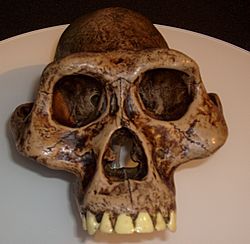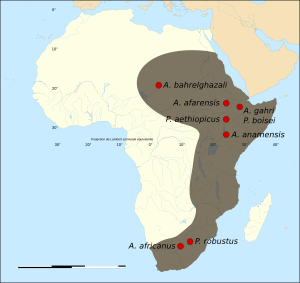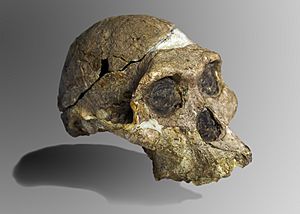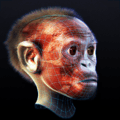Australopithecus facts for kids
Quick facts for kids AustralopithecusTemporal range: Pliocene
|
|
|---|---|
 |
|
| Australopithecus afarensis | |
| Scientific classification | |
| Kingdom: | |
| Phylum: | |
| Class: | |
| Order: | |
| Family: | |
| Genus: |
Australopithecus
R.A. Dart, 1925
|
| Species | |
Australopithecus is a genus of extinct human-like creatures. They are very closely related to modern humans.
The first Australopithecus fossil found was the Taung Child. It was discovered by Raymond Dart in 1925.
Most of their remains have been found in East Africa. The oldest fossils are about 3.9 million years old. Scientists believe that humans and other apes split from a common ancestor around 5 million years ago.
Many scientists think that Australopithecus eventually led to the genus Homo, which includes modern humans.
The genus Australopithecus used to include two main types. One type was lighter and more slender, called gracile australopithecines. The other type was bigger and more heavily built, called robust australopithecines.
Today, the robust forms are usually put in a separate genus called Paranthropus. This article will focus on the gracile forms of Australopithecus.
Gracile australopithecines shared many features with both modern apes and humans. They lived across Eastern and Northern Africa between 3.9 and 3 million years ago.
Contents
What Did Australopithecus Look Like?
How Big Was Their Brain?
The brains of most Australopithecus species were quite small. They were only about 35% the size of a modern human brain. This is similar to the brain size of a chimpanzee. Brain size in early human ancestors did not get much bigger until the genus Homo appeared.
What About Their Teeth and Skull?
The skull of the Taung Child had short canine teeth. The position of the foramen magnum (the hole at the base of the skull where the spinal cord connects) showed something important. It suggested that these creatures walked on two legs, a type of bipedal movement.
How Tall Were They?
Most Australopithecus species were small and slender. They usually stood between 1.2 and 1.4 meters tall (about 4 to 4.5 feet). There was also a big difference in size between males and females. This is called sexual dimorphism.
Modern humans do not show as much sexual dimorphism. For example, modern human males are only about 15% taller or heavier than females on average. However, in Australopithecus, males could be up to 50% larger than females, though usually the difference was less extreme.
Did They Walk Upright?
Yes, they did! Several clues tell us this. Their skeleton, the fossil footprints found at Laetoli in Tanzania, their canine teeth, and the position of the foramen magnum all point to one thing: these ancient apes walked on two legs. This means they had achieved bipedalism.
How Did Australopithecus Evolve?
Scientists once thought that Australopithecus africanus was the direct ancestor of the genus Homo (especially Homo erectus).
However, some fossils belonging to the genus Homo have been found that are older than A. africanus. This means a few things could have happened. Either the genus Homo split off from Australopithecus much earlier (perhaps from A. afarensis or an even older form like Kenyanthropus platyops). Or, both Australopithecus and Homo developed from a common ancestor independently.
Scientists have studied the DNA of humans and chimpanzees. They believe that human ancestors (like Ardipithecus, Australopithecus, and Homo) and chimpanzee ancestors (Pan troglodytes and Pan paniscus) separated from a common ancestor about 5 to 6 million years ago. This idea comes from something called a "molecular clock," which estimates how long ago species diverged based on genetic differences.
However, some recently discovered human-like fossils are older than what the molecular clock suggests. For example, Sahelanthropus tchadensis (also called "Toumai") is about 7 million years old. Orrorin tugenensis lived at least 6 million years ago. Because we don't know much about these older fossils, they are still debated. The molecular clock suggests humans and chimpanzees split later.
One idea is that the human and chimpanzee groups first separated, then some populations might have interbred about a million years later. Another idea is that the "molecular clock" might not be perfectly accurate. The molecular clock works by assuming that changes in DNA happen at a steady rate over long periods. Researchers like Ayala have questioned if this assumption is always true.
Images for kids
-
Taung child's skull
-
Reconstruction of a largely hairless male A. sediba by Adrie and Alfons Kennis at the Neanderthal Museum, Germany
-
The spot where the first Australopithecus boisei was discovered in Tanzania.
-
Taung Child by Cicero Moraes, Arc-Team, Antrocom NPO, Museum of the University of Padua.
See Also
 In Spanish: Australopithecus para niños
In Spanish: Australopithecus para niños








